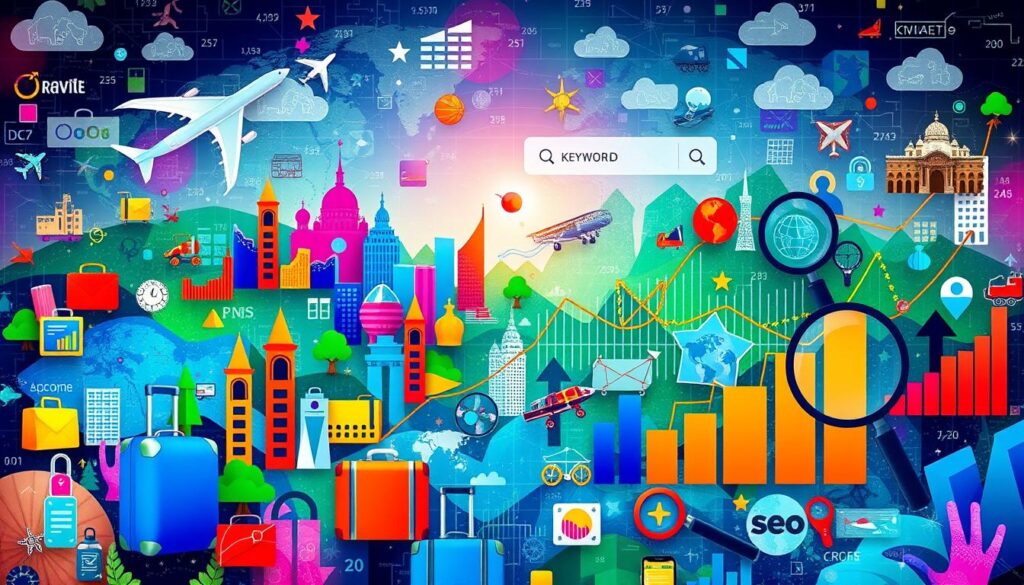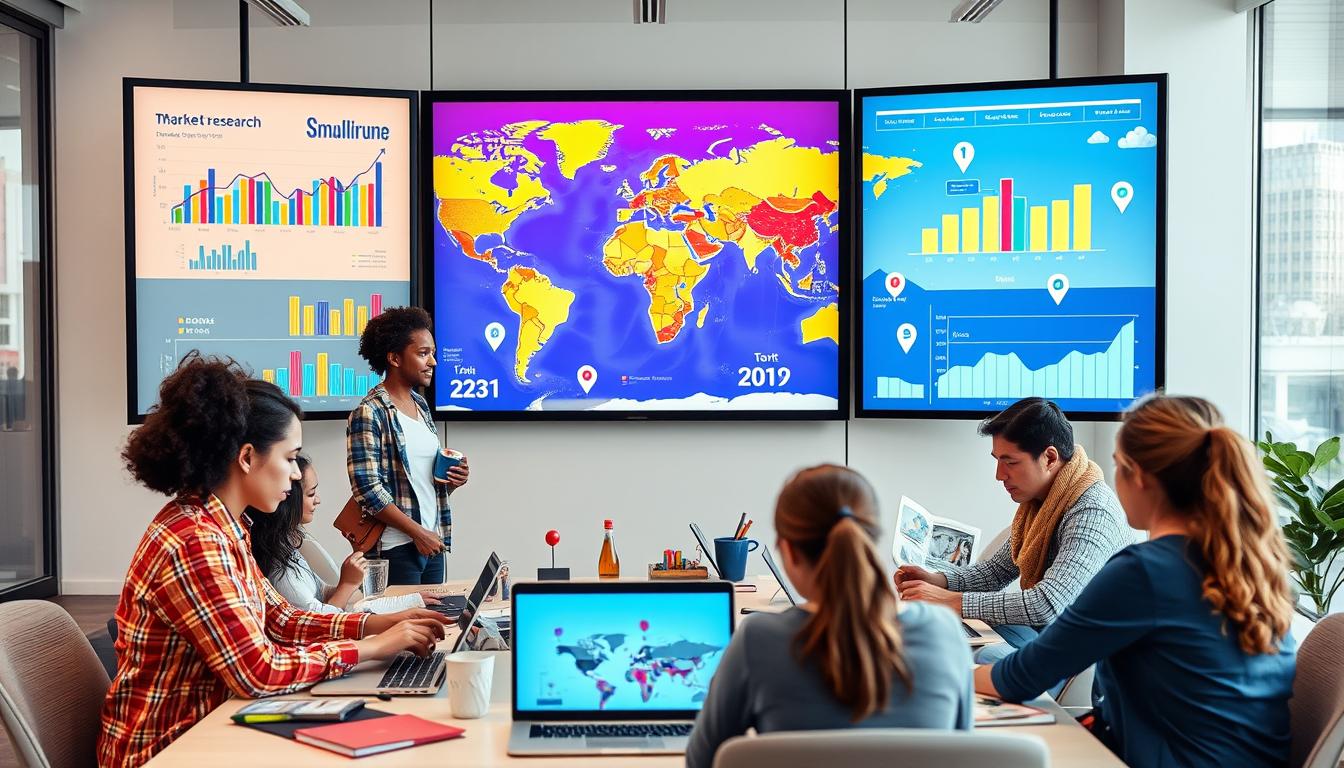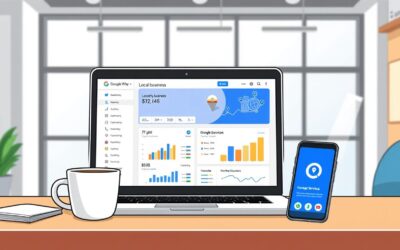The global tourism industry is set to reach $14.77 trillion by 2029. As competition grows, 89% of consumers rely on online reviews before buying. To stand out, travel companies must use innovative digital marketing strategies for the travel industry.
Several key trends are shaping digital marketing for travel and tourism in 2024. These include influencer marketing, sustainability, and personalization. Companies must stay ahead to attract and keep customers.
Effective tourism marketing strategies can create compelling campaigns. These drive engagement and boost conversions. Businesses can thrive by using the latest digital marketing trends for travel.
Key Takeaways
- Personalization through data analytics can significantly increase engagement and conversion rates for travel marketing efforts.
- Consumers increasingly opt for eco-friendly travel options, making sustainability a key focus in tourism marketing.
- Videos and interactive content can boost engagement and drive conversions in travel marketing strategies.
- Collaborating with micro-influencers can help reach targeted, niche audiences and build brand credibility.
- Proper SEO optimization can lead to a 42% increase in organic website traffic for travel and tourism businesses.
We’ll explore effective digital marketing strategies for travel businesses in 2024. This includes tackling industry challenges and crafting multi-channel marketing plans. We’ll also cover leveraging influencer partnerships to help your business thrive.
The Importance of Digital Marketing in the Travel and Tourism Industry
Digital marketing is crucial for the travel and tourism industry in our online world. It helps businesses reach potential customers through online platforms and mobile devices. This tool is essential for success in the sector.
Tourism digital marketing agencies are on the rise, reflecting changing consumer habits. Travelers now use digital channels to plan and book trips. This makes a strong online presence vital for businesses.
Digital marketing allows precise targeting of audiences based on various factors. It uses data analytics and digital advertising platforms to reach the right people.

Effective strategies inspire travelers and position businesses as reliable brands. They streamline the customer journey and offer top-notch experiences. Unique content and social media engagement build brand loyalty and encourage positive reviews.
35% of travelers seek ideas from social media. 50% of people under 40 rely heavily on these platforms for trip inspiration.
Digital marketing enables real-time tracking of website traffic and booking conversions. This data helps optimize marketing strategies. It also allows for more personalized trip experiences and trend spotting.
| Digital Marketing Strategy | Benefits for Travel and Tourism Industry |
|---|---|
| Search Engine Optimization (SEO) | Increases visibility in search results, drives organic traffic |
| Social Media Marketing | Engages audiences, inspires travelers, builds brand loyalty |
| Email Marketing | Keeps in touch with customers, promotes exclusive deals |
| Influencer Marketing | Enhances brand visibility, boosts sales throughout the year |
Digital marketing offers many benefits to the travel and tourism industry. It simplifies global information sharing through social media. It helps shape perceptions and gain a competitive edge in the market.
Travel companies can inspire travelers and streamline the customer journey with digital marketing. This powerful tool drives growth in the dynamic travel industry.
Understanding the Unique Challenges in Travel & Tourism Marketing
Travel and tourism marketing faces unique hurdles. These include seasonal changes and diverse audiences. Marketers must adapt their strategies to overcome these challenges.

The global travel sector contributed 9.1% to global GDP in 2023. This was a 23.2% increase from the previous year. Hotels and vacation rentals compete in a market ruled by online booking platforms.
Transportation providers focus on rebuilding trust after COVID-19. They emphasize health measures and effective communication. These steps are crucial for their success.
Seasonality and Market Fluctuations
Seasonality is a major challenge in travel marketing. Demand often peaks during specific periods. To manage off-peak seasons, marketers can use various strategies.
- Retargeting campaigns to re-engage past visitors
- Content marketing to showcase off-season attractions
- Email marketing with personalized off-peak offers
- Social media contests to generate buzz during slower periods
- Influencer partnerships to promote off-season travel
- Dynamic pricing to incentivize bookings during low demand
Pausing PPC campaigns during slow seasons may save money. Instead, focus on organic social media and SEO. This maintains visibility without overspending.
Targeting a Diverse Audience
The travel industry caters to many demographics. Each group has unique preferences and behaviors. Consider these personalized marketing approaches to target diverse audiences:
| Approach | Description |
|---|---|
| Behavioral targeting | Tailor content based on user behavior and interests |
| Dynamic content | Customize website content for different audience segments |
| Lookalike audiences | Target users similar to your best customers |
| Geo-targeting | Deliver location-specific content and offers |
| Customer journey mapping | Understand and optimize touchpoints for each audience |
| Multi-language support | Cater to international audiences with localized content |
Refined audience targeting helps marketers focus on potential customers. It prevents wasting resources on uninterested groups. Shore Excursions Group saw profits rise after using targeted PPC for specific cities.
Crafting an Effective Digital Marketing Strategy for Travel & Tourism
A winning travel marketing strategy needs clear objectives and audience understanding. Travel companies can drive bookings by focusing on these key elements. A multi-channel approach helps engage target markets effectively.
Setting Clear Marketing Goals
Start by setting SMART goals for your digital marketing strategy. These should be Specific, Measurable, Achievable, Relevant, and Time-bound.
For example, aim to increase website traffic by 25% in six months. Or boost online bookings by 15% during the off-peak season.
Set KPIs and review progress regularly. This ensures marketing efforts align with business objectives.
| Goal | KPI | Timeframe |
|---|---|---|
| Increase website traffic | 25% growth | 6 months |
| Boost online bookings | 15% increase | Off-peak season |
Conducting Market Research
Understanding traveler behavior is key to developing targeted marketing strategies. Use tools like surveys, social listening, and Google Trends for insights.
Competitor analysis, customer interviews, and analytics platforms reveal audience demographics and booking habits. Research shows travelers spend over five hours consuming online content before booking.
This highlights the importance of engaging, informative content in the customer journey.

Developing a Multi-Channel Marketing Plan
Create a plan covering all stages of the customer journey. Include SEO to boost visibility and social media to engage specific niches.
Use email marketing for special offers and influencer partnerships to reach new audiences. A holistic approach guides potential customers through the booking process.
Personalized campaigns increase the chance of conversion.
An effective strategy requires a data-driven, customer-centric approach. Set clear goals and conduct thorough market research.
Develop a cohesive multi-channel marketing plan. This helps businesses navigate industry challenges and drive meaningful results.
SEO Strategies for Travel & Tourism
SEO is vital for travel businesses to boost online visibility. It helps improve search rankings and reach a wider audience. Companies can drive more bookings and revenue with effective travel SEO.
Keyword Research and Optimization
Keyword research is crucial for successful SEO campaigns. Identify relevant keywords for your travel business to optimize content and meta tags. Focus on destination-specific keywords and long-tail phrases to attract qualified traffic.
Incorporate keywords into page titles, meta descriptions, and header tags. This improves your on-page optimization and helps capture potential customers at each stage.

Organic search is key in the travel buyer’s journey. It starts broad and becomes more specific as users near the booking stage.
Creating High-Quality, User-Centric Content
Content marketing is essential for travel SEO. Create informative and engaging content to attract and retain your target audience. Develop destination guides, travel tips, and blog posts that address customer needs.
Include user-generated content like reviews and photos to build trust. This helps establish your brand as a go-to travel resource.
“Only 29% of marketers actively use content marketing.”
Quality content improves SEO performance and encourages social sharing. It also attracts backlinks, further boosting your online visibility.
Local SEO for Travel Businesses
Local SEO is crucial for travel businesses with a physical presence. Optimize your Google My Business listing to improve local search rankings. Ensure your business information is accurate across all online platforms.
| Local SEO Strategy | Benefit |
|---|---|
| Claim and optimize Google My Business listing | Improve visibility in Google Maps and local search results |
| Encourage customer reviews | Build trust and credibility with potential customers |
| Include local keywords in content | Attract nearby customers searching for travel services |
Ask satisfied customers to leave reviews on your Google My Business page. Positive reviews improve local SEO and influence potential customers’ decisions.
Implement keyword research, content marketing, and local SEO to boost online visibility. These strategies help attract more qualified traffic and drive bookings. Stay ahead with effective travel SEO as the industry grows.
Leveraging Social Media for Travel & Tourism Marketing
Social media is vital for travel businesses to connect with customers. Instagram, Facebook, and Twitter offer chances to showcase visuals and share stories. These platforms help boost online presence and drive bookings.
Visual content reigns supreme in travel social media marketing. Stunning photos and videos of landscapes and activities inspire wanderlust. They entice potential customers to book their next adventure.
Recent reports show social media’s impact on travel choices. Nearly 35% of travelers use it for holiday inspiration. 75% pick destinations based on social media influence.
Engaging with customers builds brand loyalty and drives sales. Responding to comments and sharing user content fosters trust. This interaction strengthens relationships and encourages word-of-mouth marketing.
Travel businesses should tailor content to each platform’s unique features. They must consider user demographics too. This approach maximizes marketing efforts.
- Instagram, with its highly visual nature, is popular among Millennials and Gen Z.
- Facebook appeals to Boomers and Millennials, offering a mix of visual and informative content.
- TripAdvisor attracts Millennials due to its wealth of user-generated reviews and recommendations.
- Pinterest, known for its inspirational boards, has a predominantly Millennial user base.
- YouTube caters to Boomers, Millennials, and Gen Z, providing detailed and informative travel content.
- LinkedIn is ideal for B2B travel marketing, offering a platform for sharing industry insights and networking.
Understanding platform strengths helps create targeted campaigns. Airbnb’s #LiveThere campaign on Instagram is a great example. It encouraged users to share authentic travel experiences.
The campaign gained over 3.5 million mentions. It led to a 300% growth in Airbnb’s Instagram following.
Staying ahead of social media trends is key for success. New features like Stories and AR ads create engaging content. These tools capture potential travelers’ attention.
Monitoring and adapting to trends helps travel businesses stay competitive. It allows them to harness social media’s power effectively. This approach drives growth in the changing digital landscape.
The Power of Influencer Marketing in Travel & Tourism
Influencer marketing has revolutionized the travel and tourism industry. Businesses can now reach vast networks by partnering with popular social media personalities. This strategy builds credibility among target audiences, tapping into the 50% of people worldwide with active social accounts.
Instagram is crucial for influencer marketing in tourism. Travel influencers like @muradosmann (4 million followers) and @chrisburkard (3.5 million followers) have massive followings. @izkiz and @doyoutravel (2.7 million followers) are also valuable partners for travel brands seeking to expand their reach.
Identifying the Right Influencers for Your Brand
When choosing influencers, consider their niche, audience demographics, and engagement rates. Nano and micro influencers offer authentic connections with smaller, highly-engaged followings. These influencers often have loyal audiences, making them ideal for reaching specific market segments.
Key factors for identifying the right influencers include:
- Niche and content alignment with your brand
- Audience demographics and location
- Engagement rates and audience interaction
- Authenticity and transparency in their content
Crafting Effective Influencer Marketing Campaigns
Develop a strategy that aligns with your brand’s goals and values for successful influencer marketing. Authenticity and transparency are highly valued on social media in 2023. Ensure your influencer partnerships feel genuine and organic.
Consider these trends and best practices for your campaigns:
| Trend | Description |
|---|---|
| User-generated content (UGC) | Encourage influencers to create content that feels authentic and relatable to their audience |
| Short videos and snackable content | Focus on creating engaging, bite-sized content that captures attention and is easily shareable |
| Immersive experiences | Collaborate with influencers to showcase unique, immersive travel experiences that inspire wanderlust |
Travel businesses can reach new audiences and build brand awareness through effective influencer marketing. This strategy can drive bookings in 2024 and beyond. By choosing the right influencers and crafting compelling campaigns, success is within reach.
Email Marketing Strategies for Travel & Tourism
Email is a powerful tool for travel businesses to connect with their audience. Online sales make up two-thirds of global travel revenue. 80% of holiday packages are now booked online.
Personalization and segmentation are key to effective email marketing. Tailoring content to specific audience segments can increase open rates by 39%. Targeted promotions ensure subscribers receive relevant and engaging content.
Automation streamlines email marketing efforts. Welcome emails capture preferences, while follow-ups include countdown timers and reminders. These campaigns enhance customer engagement before trips. Seasonal promotions can build excitement and influence decision-making.
Compelling newsletter content keeps subscribers engaged and encourages bookings. Travel tips, exclusive offers, and behind-the-scenes glimpses showcase your brand’s expertise. Strong headlines, engaging visuals, and mobile-friendly designs impact open rates and conversions.
| Email Marketing Tactic | Impact on Engagement |
|---|---|
| Personalized content based on preferences | 39% increase in open rates |
| Using emojis in subject lines | 56% of brands experience increased engagement |
| Sending newsletters during peak engagement times | 6% boost in average open rates and click-through rates (CTR) |
Global email users are projected to reach 4.6 billion by 2025. This shows vast potential for travel industry email marketing. Businesses can effectively connect with their audience and drive bookings.
Leveraging personalization, segmentation, and automation helps build brand loyalty. Engaging newsletter content is crucial in an increasingly competitive market.
Best Practices for Digital Marketing in Tourism
Tourism digital marketing success requires staying ahead of trends. User-generated content (UGC) is a powerful strategy. It showcases authentic experiences and boosts engagement without high costs.
Branded hashtags, like Ritz-Carlton’s #RCMemories, can create a strong community around your brand. Virtual reality (VR) experiences offer immersive tours of destinations and activities. This technology can transform decision-making and set your business apart.
Customer reviews are crucial in today’s digital landscape. 89% of global consumers rely on online reviews when making decisions. Maintain a strong presence on platforms like TripAdvisor and Viator.
Experiential marketing creates memorable, immersive events and interactive installations. These experiences encourage visitors to share on social media. This organic sharing increases brand awareness and attracts new customers.
Data analysis helps make informed marketing decisions. It allows you to tailor offerings to your target audience’s needs. Understanding consumer preferences helps create targeted campaigns that drive bookings.
Social media marketing engages users throughout their travel journey. Platforms like Facebook and Instagram offer targeted advertising and influencer partnerships. Interactive campaigns like contests and scavenger hunts can boost engagement.
Embracing these practices helps businesses thrive in the competitive travel industry. It allows you to create unforgettable experiences for your customers.




0 Comments